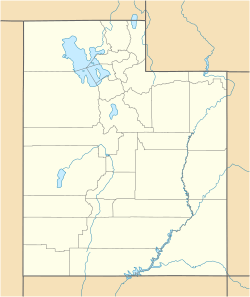Venice, Utah facts for kids
Quick facts for kids
Venice, Utah
|
|
|---|---|

The old Venice School
|
|
| Country | United States |
| State | Utah |
| County | Sevier |
| Settled | 1875 |
| Founded by | Francis G. Wall |
| Elevation | 5,223 ft (1,592 m) |
| Time zone | UTC-7 (Mountain (MST)) |
| • Summer (DST) | UTC-6 (MDT) |
| ZIP code |
84701
|
| Area code(s) | 435 |
| GNIS feature ID | 1446921 |
Venice (/ˈvɛnɪs/ VEN-iss) is a small, unincorporated community in Sevier County, Utah, United States. This means it's a group of homes and businesses that isn't officially a city or town with its own local government.
Contents
Exploring Venice, Utah
Venice is a quiet farming community. It is about 5 miles (8 km) northeast of Richfield, which is the main town in the county. Venice is located near State Route 118 and State Route 119.
The Sevier River flows right through the middle of Venice. To the east, there is a rocky hill called the Black Knoll. On this hill, you can see a large letter "V" made of rocks. This "V" stands for Venice! The community was named after the famous city of Venice, Italy.
The Story of Venice
| Historical population | |||
|---|---|---|---|
| Census | Pop. | %± | |
| 1910 | 231 | — | |
| 1920 | 275 | 19.0% | |
| 1930 | 307 | 11.6% | |
| 1940 | 301 | −2.0% | |
| 1950 | 238 | −20.9% | |
| Source: U.S. Census Bureau | |||
Early Settlers and New Names
The first person to settle in the Venice area was Francis George Wall. He bought land here in 1875. He built a cabin and moved his family to the area. As more people moved in, the settlement was first called Wallsville, named after him.
An important part of the community was the bridge over the Sevier River. The first bridge was built around 1885. In 1887, a log building was built. It was used as both a school and a church.
Growing Up: Post Office and New Name
A post office opened in the local store in 1894. By 1900, the community was growing. Residents decided to change the name of their town from Wallsville to "Venice."
Schools and Buildings
In 1900, a new white brick schoolhouse was built. This school taught students until 1924. After that, a new school building was constructed in Venice. The old brick school was then sold and used as a church building until 1984. The school that opened in 1924 closed in 1950. However, that building still stands today and is a well-known landmark in Venice.
Railroad Connections
For many years, the Denver and Rio Grande Western Railroad was very important for Venice. It ran through the community, helping farmers send their crops to other places. It also carried passengers. The railroad line was closed after a big landslide in 1983.
Life and Work in Venice
Farming and Sugar Beets
Farming has always been the main way of life in Venice. For a long time, especially in the early 1900s, farmers grew a lot of sugar beets. These beets were a very important crop that farmers sold for money.
At first, farmers sent their sugar beets to a factory in nearby Elsinore. When that factory closed in 1928, they had to send their beets further away. Over the years, factories closed, and farmers had to ship their crops even longer distances. This made it more expensive for them. The last sugar beet farmers in Venice stopped growing them in 1976.
Raising Animals and Cooperatives
Raising animals is still a big part of the community's economy. Farmers in Venice raise cattle, sheep, and chickens. In the 1960s, Venice farmers worked together. They formed a group called the Venice Feed & Cattle Company. This group helped them process animal feed and sell their crops and livestock.
Learning in Venice
Students from Venice have always gone to high school in Richfield. After the Venice School closed in 1950, younger students also started going to schools in Richfield.
See also
 In Spanish: Venice (Utah) para niños
In Spanish: Venice (Utah) para niños



